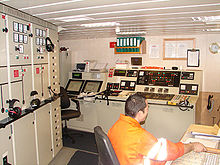This is an old revision of this page, as edited by 41.234.252.152 (talk) at 22:46, 23 March 2009. The present address (URL) is a permanent link to this revision, which may differ significantly from the current revision.
Revision as of 22:46, 23 March 2009 by 41.234.252.152 (talk)(diff) ← Previous revision | Latest revision (diff) | Newer revision → (diff)| This article does not cite any sources. Please help improve this article by adding citations to reliable sources. Unsourced material may be challenged and removed. Find sources: "Engine department" – news · newspapers · books · scholar · JSTOR (November 2008) (Learn how and when to remove this message) |

{{dablink|The term marine engineer can also refer to a designer who specializes in the design and building of marine machinery, and occasionally, specialists in naval architecture, shipbuilding,dry docking,and offshore facilities.
Marine engineers are the members of a ship's crew that operate and maintain the propulsion and other systems on board the vessel. Marine Engineering staff also deal with the facilities on board,including electric power generation plants, lighting, air conditioning and water systems. They deal with bulk fuel transfers, and require knowlage of mechanical ,air conditioning,refregeration fresh water generation and (wast oils treatment units which is very important to prevent marine polution which could lead to harming beautiful sea creatures like fish,dolphins, seabirds and marine life in general) .they are knowlageable of controle and electric engineering in addition to ship construction,naval architecture (as thy are responsible for fuel oil ,lubricating oils,and fresh water transformation between tanks on board which is a process that could be critical to the ships stability yet <the captain must be informed as a safety precaution>).computers and networking between computers on board is the engineers responsbility in most ships ,as collage and maritime accademies graduates study intense computer courses and programing while the deck side study computer as users.also welding and turning skills are essential as thy could be cretical in problem solving setuations,specialy underwater welding. like all officers on board ,engineers get coarses concerning firefighting and first aid,safety,security,polution prevention as well as in dealing with the ship's boats checks according to the international maritime organization regulations and STCW 95 convintion also thy are responsible for other technical safety and polution prevention tasks and safety systems under the supervision and responsibility of the captain
also they are involved in the design and construction of these complicated systems. New design is mostly included within the naval architecture or ship design. The field is concidered a branch of mechanical engineering, although the modern marine engineer requires knowledge (and hands on experience) with electrical, electronic, pneumatic, hydraulic, chemistry, control engineering, naval architecture, process engineering,steam generations gas turbines and even nuclear technology on certain military vessels.yet still the captain of the ship with a limited knowlage in all these fields has to relay totaly on the engineering department skills cocerning these maters and he is the one held responsible and even the only one who goes to gail in case of accidents according to the maritime low as he is the representetive of both the flag authorities and the ships owner at sea.
Insignia
Engineer Officers bear the same number of stripes, on cuffs and on epaulettes, as Deck Officers with the complementary rank. For instance, a Chief Engineer bears 4 stripes, as a Captain does, but they are distinguished by the cuffs and epaulettes bearing the purple between the stripes.
A different means, of differentiating Engineering officers from Deck officers, is by the insignia above the stripes. In some merchant fleets, a propeller is located above the Engineer's stripes, whilst an anchor or a diamond is located above the Deck officer's stripes.
Background
A ship's crew is divided into two distinct sections: those who navigate the ship and those who maintain the machinery and controls, carrying out all repair functions on-board. The navigators are deck officers and report to the Master (also functionally referred to as Captain), which is a Naval rank. Engineers are running and maintaining all machinery, reporting to the Chief Engineer. Also on board are the crew or 'Ratings', who are 'other ranks' or hands who, though not officers, play a key role in running the ship by assisting the officers in daily operations. In the Engine department, this includes Wiremen (who assist Electrical Officers), Fitters, Motormen , Wipers or utilitymen who play a large role in the daily upkeep of the engine room.
The original term Engineers (on a ship) meant the technical people who dealt with the engines , as opposed to the Consulting Engineer concept (their counterparts on land). Marine Engineers are generally more 'hands on', and work in arduous conditions with temperatures in the engine room spaces exceeding 45 - 50 degrees Celsius (122 degrees Fahrenheit). Patience and a logical approach needs to be maintained at all times, especially when dealing with heavy machinery in a seaway. Encouraging this mindset can present a leadership challenge.
There are 4 classifications of Marine Engineering licences throughout the merchant marine, those being Chief Engineer, First Assistant/Second Engineer, Second Assistant/Third Engineer, and Third Assistant/Fourth Engineer.
See also
External links
Maritime Resources
Maritime Associations
- The Institute of Marine Engineering, Science and Technology
- Society of Naval Architects and Marine Engineers